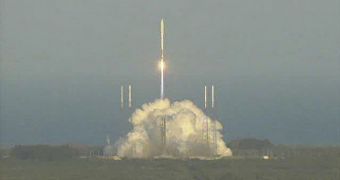The United States Air Force (USAF) launched its second unmanned space plane on Friday, March 5, from California. The flight, which is still surrounded in secrecy, managed to reach orbit successfully.
Officials with the Air Force say that the mini-shuttle, as it's called, took off from the Cape Canaveral Air Force Station (CCAFS), in Florida, at 5:46 pm EST (2246 GMT) Friday afternoon.
The Orbital Test Vehicle 2 (OTV-2), the second X-37B space plane ever constructed, was taken to orbit aboard an Atlas V delivery system. Initially, the mission was supposed to launch on Thursday, March 4, but bad weather in Florida prevented mission controllers from giving their go-ahead.
Before the launch took place, however, experts had to carry out a last-minute repair. Earlier in the afternoon, a faulty valve was discovered on the rocket, and it had to be urgently replaced.
A few minutes after the X-37B launched, the mission went into a total media blackout. The event was announced beforehand, and is justified by the fact that its mission is classified.
USAF representatives have repeatedly said that the goal of the mission is to provide a platform for testing new space technologies. Many have construed these interpretations as hints that the main objective of the space plane is to test out new surveillance technologies.
The first X-37B launched in early 2010, and landed at the Vandenberg Air Force Base (VAFB), in California, after a mysterious seven-month maiden voyage. It landed all on its own on December 3.
In essence, the vehicle is very similar to the shuttles NASA operates as part of its space fleet. The only difference is that the X-37B is unmanned, and that it's much smaller than its counterpart.
The payload bay on the space plane is about the size of a pickup truck's bed, whereas the shuttle payload bay can fit a small bus within. The vehicle was originally developed by engineers at Boeing.
It is now being developed by the USAF in collaboration with the US Defense Advanced Research Projects Agency (DARPA), after it was handed over to NASA for a short while.
The space plane “gives the Air Force the ability to test-fly some of this hardware. Part of its mission is to test out reusable technologies and to see how quickly they can turn around these vehicles and launch them again,” says Brian Weeden.
The expert, who is now a technical adviser for Secure World Foundation, is a former Air Force orbital analyst. He explains that the aircraft itself may be also a part of the tests. This is the first unmanned space plane ever constructed and operated anywhere in the world, Space reports.

 14 DAY TRIAL //
14 DAY TRIAL //